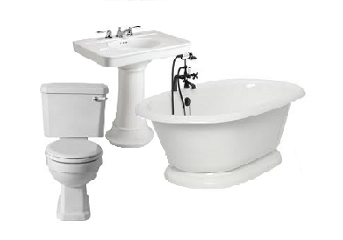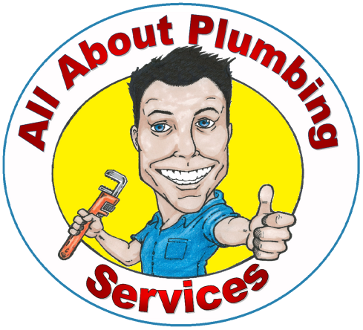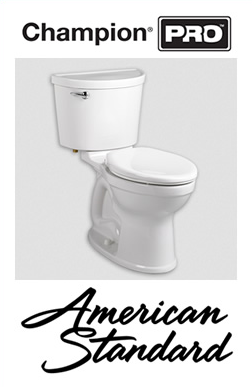 Plumbing Fixtures
Plumbing Fixtures
If you ask many people what a plumbing fixture is, they will probably reply faucet, but a plumbing fixture is actually any device that is connected to a plumbing system and interacts with water. Each plumbing feature will be designed for a particular use, and while design can vary, fixtures generally are designed with one function in mind.
The most common plumbing fixtures are bathtubs, sinks, showers, tubs, toilets, and faucets. Pipes, drains and valves are part of a home’s plumbing system that supply water to each of the plumbing fixtures and also drains it away. Normal plumbing practice is to install a valve on each water supply line leading to the fixture, and is commonly called the “water supply valve” or “stop valve". The water supply to some fixtures is only cold water (such as a toilet), and some plumbing fixtures have both a cold and a hot water supply. The water supply valve is intended as a safety feature. If a plumbing fixture breaks or leaks, the water supply valve can be closed to stop unwanted water from accumulating and causing damage.
To turn the water supply off, locate the stop valve usually found on the flex or feed pipe leading into the fixture. Turn it clockwise until it stops. If you cannot locate a water supply valve, you may need to turn the water off at the main. This valve is typically located in front of the house just below the garden hose faucet. Sometimes the main is located in the water meter box, usually underground near the street. A street key is required for access, so you may need to call your local water department or our friendly staff at All About Plumbing for assistance.
To extend the life of your plumbing fixtures, keep them clean, watch for leaks, and make sure that your water pressure is checked by a master plumber periodically. Typically, water pressure should be around 60 PSI. All About Plumbing Services offers Professional Plumbing Maintenance Plans. Check out our Plumbing Maintenance Page for more information.
Sinks
A sink is a bowl shaped plumbing fixture that is usually used for washing hands, dishes and other small objects. Often called a basin there are usually several sinks in every household. Each sink will have a faucet that provides both hot and cold water and a drain. Sinks often become clogged due to soap and debris that builds up and gets trapped in the piping. In some cases you may need to call in a professional plumber like All About Plumbing Services to unclog the pipe.
Sinks are used daily and everyone looks and notices them. You can go to super stores and get the same plain white sink that everyone else has, or you can take the time and research and look for different styles and varieties that fit your needs.
There are many types of sink material to choose from and although most sinks are made with vitreous china, they can be made with wood, metal, stone and glass. Cast Iron sinks are durable and long lasting and has been a top choice for many decades. Modern cast iron sinks are available in a rainbow of colors and can lend traditional charm to any décor. Composite sinks offer the best scratch, heat, and chip resistance. They are heat resistant to 535 degrees and available in a huge array of top designer colors. Modern methods even allow sinks to be made in the same material as the counter top providing a seamless connect between top and sink.
Sinks come in many shapes and varieties. The most common types of sinks are:
- Self-rimming sinks (Drop In Sinks) - Self-rimming sinks are designed to drop into the hole in your kitchen counter top or bathroom vanity. A more traditional style, the drop in sink is found in many homes in a variety of materials including porcelain, enameled cast iron, stainless steel and vitreous china. Self-rimming sinks are suspended by the rim and when installed correctly the seal between the sink and counter top is water tight. They are one of the most common types of sinks because they can be used in any type of vanity. Although the sink itself may be very easy to clean and maintain, dirt and grime can get caught where the sink meets the counter top. Despite the extra effort it may take to keep clean, this type of sink has been a classic choice for many years.
- Bottom-mount sinks (Under mount) - Bottom Mount sinks are mounted below the counter top to add a seamless finish and sleek look to the kitchen workspace or bath. An under mount sink can give your granite, marble, or other counter tops more appeal due to the lack of an unattractive "lip" that ordinary kitchen sink bowls have. High strength epoxy or silicone caulk and metal anchors that are adhered to the underside of the counter top provide the strength to hold the under mount sink in position for a lifetime of leak free performance. Because bottom mount sinks are clamped underneath the counter top, the hole must have a finished edge. The additional cost of ‘finishing’ the hole may make bottom mount sinks more expensive, but they are considered more contemporary and classy than the self-rimming sinks. Single, double, and even triple bowl under mount sinks are available and are extremely easy to keep clean.
- Above Counter Sinks (Vessel) - A vessel sink sits on top of the counter rather than being mounted in or below the counter top. This opens up a lot of design opportunities because the sink is not confined to fitting a straight counter top edge. Because vessel sinks come in so many shapes and sizes and require surface-mounted faucets, it is strongly advised to find a sink and measure the height before purchasing or installing a faucet. vast choice of materials that you can use for a vessel sink. China, stainless steel and cast iron can keep the look a little more traditional. Glass, metal and natural stone can give your bathroom a more dramatic feel. Marble is a popular choice for vessel sinks and since a marble vessel sink is usually formed and polished from a single piece of stone, the finished product may look more like a piece of sculpture than a bathroom sink.
- PEDESTAL SINKS - Pedestal sinks offer more room in the bathroom, but also offer little space for storage. These sinks are better used as guest bathroom sinks or even in powder rooms where storage is not necessary. They are very easy to clean and maintain and are a popular choice for smaller bathrooms.
- WALL-MOUNTED SINKS - Like Pedestal sinks, wall-mounted sinks don't take up much space and offer little storage. These sinks are recommended for bathrooms that aren't used often.
- Farmhouse (Apron) - The farmhouse sink is also called an apron sink because of the drop down "apron" style. The farmhouse sink is designed for a lot of use and even rugged abuse. While homeowner who wants the most authentic looking farmhouse sink will go for a white, ceramic, or fireclay model, farmhouse sinks are also available in other materials such as stainless steel and copper.
- Utility Basin – Usually found in laundry rooms or garages, utility basins are usually large sinks used for cleaning, mopping and other chores requiring a deep basin or lots of water. Make sure to always maintain a strainer in the drain to mop strings and other debris from clogging your pipes.
- Bar Sinks – bar sinks are very convenient and available in tons of sizes, models, and finishes. Customizing the bar area of your home with a bar sink is an inexpensive update that everyone can appreciate.
Tubs
A bathtub is a large container that is filled with warm or hot water and allows a person to bathe while fully immersed in the water. Modern bathtubs are made from fiberglass and acrylic, but more expensive and often more durable baths are made from enamel, cast iron, steel and luxurious waterproof wood. Most modern baths have overflows, drains and faucets (taps) that assist in the delivery and draining of water. As manufacturing techniques have advanced, the number and variety of tubs available has increase. The most common bath tubs are:
- Western-style bathtubs – Found in the majority of households, western style tubs are long and generally thin and allow the bather to be fully immersed. Generally they are covered by a cabinet and the plumbing is hidden in an attached wall.
- Eastern-style bath tubs - Eastern tubs are shorter and deeper than the western tub and allows the person to bathe sitting or standing up.
- Claw-foot Tub – While antique claw-foot tubs are made of cast iron, today claw-foot tubs are made from modern materials such as acrylic and are less expensive. Claw-foot tubs generally hold more water than a standard tub and are designed to stand alone without any need for a cabinet or to be attached to the wall. They add elegance to any bathroom.
- Whirl-pool tubs – many newer homes come with a whirl pool tub. These incorporate nozzles that use air or water to provide a relaxing massage. They are usually bigger than a standard bath, require cabinets, and are usually attached to a wall.
If you’re like many people, you probably don’t think a whole lot about bathtub maintenance. It’s important to remember that your bathtub is likely the focal point of your bathroom, so it is important to clean and maintain your tub properly. As a general rule of thumb, a nonabrasive liquid cleaning solution that does not contain acetate, along with a soft cloth and hot water, can be used to clean most surfaces. Check the manufacturer’s recommendations to avoid damaging the surface of your tub.
Maintaining a Jacuzzi tub is a little more complicated and very important. The jets can get dirty and it is important to read the owner’s guide on the correct way to clean them and make sure they stay free of mold, mildew, and any residue that might damage the jets.
Cleaning is not the only maintenance required. Over time, caulk and sealant can deteriorate, allowing water to leak behind the finish materials and fixtures. These leaks are often difficult to detect until they have caused significant damage within the wall cavity. To prevent water damage outside of your bathtub or shower, the following inspections should be completed.
- Seal the tile and grout twice a year to add additional protection from mildew growth.
- Check for loose or damaged tile and missing or cracked grout. Repair immediately to prevent water from infiltrating into the wall cavity.
- Inspect the caulk or sealant for deterioration around the bathtub and shower unit. Also, inspect the ceiling below your bathroom for signs of leakage. Caulk or sealant should be applied around fixtures, at the wall to unit transition, and at the gap along the floor.
- If your bathtub or shower has a door, the track and frame should also be sealed to prevent water from exiting the unit.
- Check for leaky or loose wall tiles by pressing on them where they come in contact with the bathtub. If the wall is soft, there might be some water damage. Loose or hollow tiles can be an indication that there is, or was, a leak that has caused rotting underneath or behind the tile. Water that goes through the cracks will look like a plumbing leak on the ceiling below
Through cleaning and proper maintenance, your bathtub or shower will remain attractive in appearance, water will remain in its intended location, and you will ensure a healthy and bacteria free environment.
Showers
A shower can be part of the bath or a stand-alone stall. The standard shower common to most households is a plumbing fixture that uses the house’s water pressure to propel water through one or more shower heads. Though the concept has remained mostly unchanged since the late 19th century, there is a vast array of modern shower hardware and updates that can be incorporated. From water efficient shower heads that can produce different effects and different pressures to retrofitted steam showers, there are upgrades to suit everyone’s needs.
There is a vast array of shower hardware for all types water-saving showerheads use the latest technologies to save water while actually improving your showering experience. A water efficient shower head can help reduce water consumption by up to 40%. They are inexpensive and can save a family of four up to 17,000 gallons of water a year.
Toilets
A toilet is probably the most important plumbing fixture in any household. It uses a flush system to move waste out of our homes into a septic tank or a community sewage system. Although toilets are sturdy and reliable components of the plumbing system, because they are in constant use, toilet problems will almost always eventually occur. Clogging is perhaps the most common toilet trouble, but it is far from the only one. The purpose of the tank is to contain the water needed to flush the toilet and to conceal the plumbing parts that fill and empty the tank. These parts wear out and need to be replaced periodically to maintain a properly functioning toilet.
Toilet maintenance is fairly simple. Never flush cotton swabs, cotton balls, hair, facial scrubs, diapers, sanitary products, wet wipes or similar items down the toilet. These items will not easily dissolve and are responsible for most clogs. Make sure toilets flush properly. If the handle must be held down for a thorough flush or jiggled to stop the water from running, you may need to replace worn tank parts. They're inexpensive and you'll notice a lower water bill once they're replaced.
Inspect the tank and bowl for cracks or leaks. Push and pull the toilet gently to see if it rocks or moves. Check around the base of the toilet for signs of water damage (rolled vinyl, black or white stains, etc.) Check for leaky or loose wall tiles behind the toilet. If the wall is soft, there might be some water damage.
One way to find out if you have a toilet leak is to place a drop of food coloring in the toilet tank. If the color shows up in the bowl within 15 minutes without flushing, you have a leak. Make sure to flush immediately after this experiment to avoid staining the tank and call All About Plumbing Services for a fast inexpensive repair.
Replacing an existing toilet is an easy and cost-effective way to spruce up your bathroom. Updating your existing toilets to high efficiency toilets will reduce your water consumption and save you money on your water bill. There are even some high tech toilets that are heated, auto-flushing, self-cleaning, and can even check your blood pressure!
Faucets
A dripping faucet is one of the most common plumbing problems you will come across. Faucets are essentially a plumbing valve. They are used to control the flow of water into the sink or bath. They come in a variety of shapes and sizes, but it is worth spending a little extra to get quality taps and faucets as they are the most used plumbing fixture in the house and tend to have the highest failure rate. Some faucets are just simply made better than others with higher quality material such as solid brass, which generally provides a superior look, performance, and durability. While you may pay more for a quality faucet, you're likely to receive more value for your money as a result of longer, more reliable, trouble-free service.
Standard size sink openings and faucet dimensions are used throughout the U.S. plumbing industry. Generally, the standard distance between hot and cold inlets or the mounting hardware for both single and two-handle kitchen model faucets is 8" from center to center and 4" from center to center for bathroom faucets. However, because there are a few exceptions, it is always a good idea to check sizes first before placing your order.
Drains
Most plumbing fixtures have drains. Unwanted water is released from the plumbing fixture through the drain where it travels through the pipes to a septic system or community sewage system. Each drain should be protected by a strainer to prevent hair, soap, and debris from clogging the lines.
Each drain has a trap in its line. Traps are pipes which curve down then back up retaining a small amount of water in the curve. This water acts as a seal, preventing noxious sewer gases from entering your home. Most Drains must be vented so that negative air pressure cannot siphon the trap dry and to prevent positive air pressure in the sewer from forcing gases past the water seal.
Maintaining drains is important to prevent backups and other plumbing problems. Check each sink, shower and tub drain for the speed of drainage. Slow drainage usually indicates a clog in the drain or a blocked vent pipe. Your drains should have a full swirl when draining. If bubbles appear when water is draining, this is usually a sign of a problem. If there are gurgling sounds, there may be venting problems. See our drain cleaning page for more information.
Drains are evaluated and inspected with most of our professional maintenance agreements. Read more about it on our Plumbing Maintenance Page.












